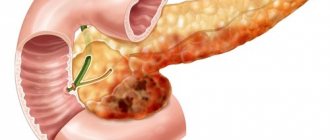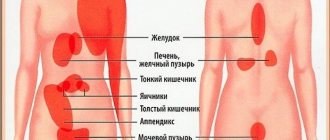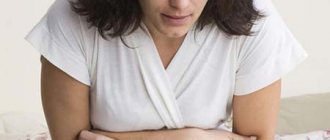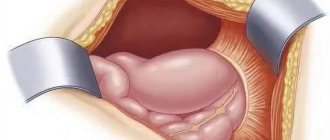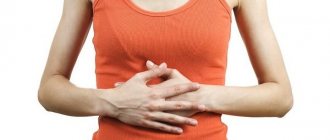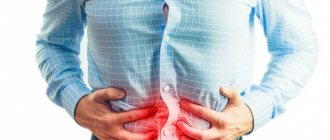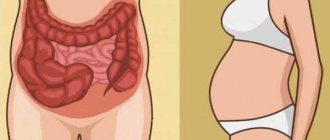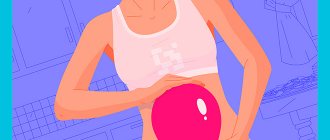Anatomy of the left side of the human abdomen
To successfully diagnose the underlying disease and understand the causes of pain, you need to know what is on the left side of a person’s lower abdomen. Any organ can cause pain. Thanks to the work of the nervous system, pain is often reflected onto a neighboring organ (this often happens with the kidneys). Such pain in medicine is called “referred”.
Medicine identifies the following bone formations and organs in the left abdominal cavity:
- abdominal wall and lower ribs;
- spleen;
- pancreas;
- duodenum, small and large intestines;
- left kidney and ureter;
- vessels and nerves of the abdominal cavity.
Each of these areas of the human body can cause discomfort and pain. An accurate diagnosis can only be made by the attending physician based on the results of tests and studies.
Pain in the left side - what could it be?
Pain in the left side can occur due to pathologies of any of the organs located in this area. Depending on the cause of the pain, it can manifest itself in different ways - be paroxysmal or constant aching, radiate to the back or encircle. In addition, the appearance of pain in the left side can be caused by other ongoing diseases, such as diabetes mellitus, heart disease, blood disease, connective tissue disease, circulatory system disease, hernia, pathology of the respiratory system and nervous system.
Read: Uterus. Some diseases, pathologies and serosometer of the uterus
Pain in the left side is divided according to the mechanism of its occurrence and characteristics:
- Visceral pain. These are typical for gastric motility disorders, muscle fiber sprains and spasms. The pain can be dull and aching or cramping. It can radiate to nearby areas of the body.
- Peritoneal pain. Caused by irritation of the peritoneum, it is distinguished by clear localization and persistence. When moving and breathing, it usually intensifies and becomes cutting.
- Referred pain in the side occurs due to irradiation of sensations. It can occur with left-sided pneumonia, pleurisy and other diseases.
Video about pain under the left rib:
Causes of pain in the left side of the abdomen
Now you know what is on the left side of the stomach. Painful sensations in this area can be caused by many diseases, both chronic and acute. Most of the symptoms of pain are associated with damage to the pancreas and gastrointestinal tract.
There are the following types of pain:
- Organ pain, which is characterized by the presence of pathology of one or more organs. This can be an inflammatory, infectious, ischemic process. At the same time, the sensations change: they fade away, then return with renewed vigor. The pain can be either acute or aching in nature.
- Parietal pain is characteristic of the abdominal wall and is most often associated with inflammatory processes or internal furunculosis.
- Neurogenic pain occurs when there are problems with nerve fibers, which transmit impulses between organs and the central nervous system.
- Referred or mirrored pain occurs quite often in patients and is characterized by localization in a completely different place from the location of the affected organ. For example, due to cysts on the left ureter, the patient may feel pain in the right side of the lower back.
Why does my left side hurt?
When determining the cause of pain on the left side, a number of factors are taken into account.
Localization of pain
If the left side hurts from above, it is assumed:
- diseases of the stomach and pancreas - functional dyspepsia, pancreatitis;
- food poisoning – accompanied by nausea, vomiting, and sometimes fever;
- deterioration in functionality or enlargement of the spleen - occurs when the organ is infected, after an impact the risk of rupture of the spleen increases, cyanosis appears at the level of the navel, pain radiates to the back;
- diaphragmatic hernia - heaviness and constant pain, nausea, heartburn.
The appearance of painful sensations at the waist level, between the ribs in the middle and on the side indicates the development of colitis or myositis. Tingling and throbbing pain in the lower abdomen, weakness, lack of appetite, alternating diarrhea with constipation often indicate the development of cancer of the digestive system.
Pain in the lower abdomen indicates problems with the gastrointestinal tract
Discomfort in the lower left corner of the abdomen is characteristic of the following pathologies:
- appendicitis – nagging, regular pain in the navel area, intensifies when pressed;
- gastritis – aching pain is accompanied by nausea, heartburn and dry mouth;
- intestinal obstruction - cramping, painful sensations appear regardless of food intake, with the progression of intestinal disease, negative symptoms disappear within 3 days;
- stomach ulcer - symptoms are similar to gastritis, discomfort occurs after eating, especially fatty foods, there is a decrease in appetite and vomiting.
Causes of pain in the lumbar region:
- pyelonephritis - characterized by a dull, aching pain radiating to the waist, chills, fever and weakness appear;
- pregnancy - an unpleasant, pulling sensation in the back occurs due to the strong pressure of the enlarged uterus on the organs;
- urolithiasis - negative symptoms worsen when walking quickly and after physical activity.
If a discomfort sensation appears at the back under the ribs, the following are diagnosed:
- Heart diseases - myocardial infarction, pericarditis and aortic aneurysm. They are characterized by dull, paroxysmal pain; with prolonged physical activity, colic occurs in the heart area.
- Intercostal neuralgia - pinched nerves lead to throbbing, piercing, cramping, dull or burning pain. When coughing, inhaling and exhaling, it shoots and tugs in the side.
Types of pain
Types of pain on the left side:
- Visceral. Dull or aching pain occurs due to disturbances in gastrointestinal motility - spasms appear, stretching of the muscles of the stomach and intestines occurs. With flatulence, pain is noted in the left and right sides.
- Peritoneal. Constant pain often has a clearly defined location. The main reason is the rupture of a gastric ulcer, accompanied by acute, cutting pain. Sometimes the patient describes the condition as “burning in the side.” Symptoms intensify after eating and when inhaling.
- Wandering. The patient cannot accurately describe the source of pain; it can occur in the abdomen, left and right sides simultaneously, and radiate to the leg or arm. Such pain often occurs if the side is blown.
- Reflected. Occurs with pleurisy, left-sided pneumonia - pain radiates to the left side from organs located far away. Painful sensations are noted in the ribs in front, behind or on both sides.
Wandering pain in the abdominal cavity is often a consequence of a cold
Type of pain
Pain can be of different types:
- Dull, aching pain with a simultaneous increase in temperature and excessive fatigue indicate the development of an inflammatory process in one of the organs of the reproductive system. If you regularly ache in the hypochondrium area, the reason lies in sluggish colitis or duodenitis.
- Sharp, severe pain with spasms indicates stones in the genitourinary system, rupture of the ovaries and an enlarged bladder.
- Pulling. Indicates purulent diseases of the pelvic organs and pinched hernia. A gradual increase in the intensity of negative symptoms indicates the development of cancer.
- Stitching pain signals a violation of the functionality of the kidneys; it occurs due to increased gas formation - this leads to a feeling of distension of the intestinal walls. Occasional tingling when moving is normal and disappears quickly.
Gender of the patient
Men and women have individual health problems that cause pain in the left side:
The nature and causes of pain depend on gender
| Diseases in men | Main symptoms | Women's diseases | Main symptoms |
| Prostatitis | Sharp or aching pain, worsens with urination and defecation | Ectopic pregnancy | Cramping or aching pain, uterine bleeding, low blood pressure, pale skin, dizziness |
| Prostate cancer | There are girdling pains that radiate to the back of the thigh or leg | Inflammation of the fallopian tubes | Sharp pain in the groin area, increased body temperature, vaginal discharge and painful periods |
| Urethritis | Sharp pain and bleeding when urinating, burning, itching | Endometriosis | Menstrual irregularities and nagging pain |
| Prostate stones | Sharp, stabbing pain, intensifying with defecation and erection, nausea, loss of appetite, frequent urination | Ovarian rupture | Stitching throughout the abdomen, blood pressure drops and heart rate increases |
Abdominal wall
These are soft tissues that prevent damage to the internal organs that are located on the left side of a person’s lower abdomen. When complaining of acute or nagging pain, patients most often point to the anterior left part of the abdominal wall. It consists of several layers:
- skin and subcutaneous fat - this layer is characterized by inflammation of the hair follicles, which in some cases can cause painful rashes;
- the internal organs that are located on the left side of the abdomen are protected from damage by a layer of muscles attached to the inner wall of the abdominal cavity (these are the rectus abdominis and oblique abdominal muscles);
- fascia - dense sheets of connective tissue that separate muscles.
The back and side walls of the abdominal cavity are much thicker, since powerful back muscles are located there.
Pain in the peritoneum can occur due to peritonitis, pelvioperitonitis, acute or chronic mesadenitis.
What does the nature of the pain indicate?
By the characteristics of painful sensations (they are described in words - pulling, tugging, aching, cutting, as well as weak or strong, pulsating or even) one can judge the stage of the pathological process. To determine how urgently medical intervention is needed, you need to analyze how your left side hurts?
- Dull pain is characteristic of the chronic process of inflammation. It feels weak, you can forget about it for a while and not notice it. However, if the process continues, an exacerbation occurs, in which the pain becomes more noticeable and stronger.
- A tingling sensation is characteristic of poor circulation. When an inflamed organ enlarges and compresses surrounding tissue, normal blood flow is disrupted. In addition, inflamed tissues swell, which also causes disruption of their blood supply. This is how a periodic feeling arises in which there is a stabbing sensation in the left side. The tingling sensation gives way to numbness as sensitivity decreases at the site of recent discomfort.
- Pulsation is characteristic of purulent processes. If you experience pulsating or throbbing abdominal pain, a visit to the doctor is necessary.
- Severe pain (pressing, cutting, stabbing and others) accompany acute processes. They may be the result of internal trauma. Important: if there is severe pain, it is better to see a doctor first, and then take painkillers. The doctor must see the full picture of the disease, its clear symptoms. This will ensure an accurate diagnosis. Painkillers are often antispasmodics. They disrupt the picture of the disease and “blur” its visible manifestations. Therefore, if you have severe pain, do not take painkillers, but consult a doctor immediately.
Pain in the left side can be caused by various reasons. There is only one clear conclusion: examination and treatment are necessary.
We recommend reading:
Lower left ribs
On the front left side, the ribs completely cover the area of the spleen and partially cover the left side of the stomach. In the case of splenomegaly, the spleen protrudes from under the lower rib and is easily palpable.
There are twelve pairs of ribs in total. The upper seven pairs (the so-called true ribs) are attached to the sternum in front and to the spinal column at the back. The three lower pairs of ribs (called “false ribs”) are fused, thereby forming the costal arch. Even lower are two pairs of ribs (“floating”) - they are not attached to either the sternum or the spinal column. They end in the muscle layer on the side. Some people may occasionally have a thirteenth pair of ribs - this is a physiological feature.
The spleen and its role in the body
The spleen is an unpaired organ located above and to the left in the abdominal cavity. With normal physiology, the ribs completely cover it, protecting it from injury and impact.
It is in the spleen that a number of blood cells are formed, filtration and accumulation of blood occurs, and red blood cells cease their action. The organ tissue consists of red and white pulp. The spleen is adjacent to the stomach, diaphragm, part of the large intestine, and pancreas.
Aching or acute pain occurs in the spleen with the following diseases:
- splenomegaly;
- perisplenitis;
- rupture or infarction of the spleen;
- vascular thrombosis.
With diseases of the spleen, the patient is characterized by weakness, asthenia, bad mood, and low performance. What is located on the left side of the abdomen, besides the spleen, and causes discomfort to the patient, you will find out below.
Stomach as a source of pain on the left side of the body
This organ is located in the center of the abdominal cavity, but most of it is located on the left. It is the second organ of the gastrointestinal tract after the esophagus. At the entrance to the stomach there is a ring-shaped muscular sphincter. A similar, but smaller size is also available at the outlet. The stomach is necessary for the normal functioning of the gastrointestinal tract; it is the “battlefield” of enzymes and acids produced by the pancreas, gall bladder and liver. With stomach diseases, as if by a “domino effect,” all human life and health collapses.
Patients often wonder what organ is located in the left lower abdomen, while the stomach is the source of discomfort. Pain from an ulcer can radiate through nerve fibers to the upper and lower parts of the abdominal cavity. Gastritis pain is easy to distinguish, since it is most often associated with food intake - it is aggravated by hunger and overeating. Erosion of the lower part of the esophagus and the mucous membrane of the stomach walls can also cause serious discomfort for the patient.
Stomach polyps are also a common reason for patient questions about what is on the left side of the abdomen and hurts. Gastric polyps are benign tumor formations. Most often, they develop gradually, over many years, due to the growth of the mucous membrane, which is characterized by an inflammatory process. If the polyps are small, they do not manifest themselves for many years. When it grows, it causes nagging pain in both the left and right sides of the abdomen.
Treatment
In most cases, if the disease is diagnosed in the acute stage, conservative treatment methods can be used: drug therapy and physical therapy. In chronic cases, the likelihood of surgical intervention is high. Traditional medicine recipes that help eliminate the inflammatory process are appropriate only as an adjuvant (but not the main one) in complex therapy. The high probability of developing adverse reactions indicates the need for prior consultation with a specialist.
Duodenum and its diseases
The section of the intestine that connects the stomach to the small intestine is called the duodenum. Part of it is located on the left side of the peritoneum. It has many bends, some of which also enter the right territory.
The duodenum performs the following functions:
- partial additional breakdown of food;
- maintaining an alkaline environment;
- promotes the production of pancreatic enzymes;
- It is in this part of the intestine that the main emulsification of fats occurs.
The most common ailment of this organ that provokes pain is a duodenal ulcer. This disease is characterized by aching, excruciating pain. They can appear both during the day and at night, periodically disappearing and appearing again. What is located on the left side of the abdomen and causes discomfort? These are probably manifestations of diseases of the duodenum, pancreas or kidney problems.
Pancreas
Which organ is located on the left side of the abdomen, produces enzymes, insulin and is sensitive to alcohol and poor nutrition? Of course, this is the pancreas. A small organ is of great importance in the overall well-being and functioning of a person. It is divided into left and right sides, between which the “body” of the pancreas is located. It is located retroperitoneally in the body, that is, it does not directly contact the muscular wall of the abdominal cavity. Adjacent to the posterior wall of the stomach, duodenum and spleen.
The functioning of the pancreas is important not only in digestion, but also in the endocrine system. It produces the most important hormone insulin, the lack of which develops diabetes mellitus and other endocrine and hormonal disorders.
Pancreatitis occurs with poor diet and frequent drinking of alcohol. This disease is an inflammation of the pancreas and becomes a source of severe, sharp pain. If this condition is not treated, pancreatic necrosis develops, which is almost always fatal. Pain with pancreatitis is always associated with meals and worsens after fatty foods (kebabs, fast food, pizza, fried potatoes, fatty meat) and alcoholic libations.
If the patient wonders what is on the left side near the abdomen, while experiencing sharp pain in this area, you should urgently consult a doctor. This is probably pancreatitis.
Main reasons
Depending on which organ provoked the symptoms, the pain may be short-lived, spasmodic, tingling or aching. In addition to diseases of the gastrointestinal tract, the cause may be disruptions in the endocrine system, hernia, pathologies of the cardiovascular system, nervous system and connective tissues.
Judging by the nature and intensity of the pain, the cause of the symptom is determined. Only a doctor can do this correctly, and he will prescribe appropriate therapy.
Diseases that cause symptoms
Most often, nausea with pain in the left side are diseases.
- Pancreatitis is inflammation of the pancreas due to poor diet and excessive alcohol consumption. In addition to nausea and pain, vomiting and flatulence occur.
- Gastritis is an inflammation of the gastric mucosa, accompanied by heartburn, nausea, an unpleasant taste in the mouth, and lack of appetite. With erosive formation, bleeding is possible.
- Acute appendicitis is inflammation of the appendix of the cecum. The pain can be felt in the navel area and be bursting and growing in nature, with basic physical activity. Temporary relief occurs after bowel movement or release of gases. Then the symptoms increase.
- Hiatal hernia. In addition to nausea and girdle pain in the side, heartburn and hiccups are noted.
- Pyelonephritis is an inflammation of the kidneys that begins with an increase in temperature, painful spasms appear not only in the left side, but also in the lumbar region, discomfort when urinating.
- Flatulence – abundant formation of gases, characterized by heaviness in the abdomen and bloating.
- Urolithiasis is the formation of stones in the urinary system. Often characterized by severe pain and nausea.
- Ectopic pregnancy or ruptured fallopian tube. May be accompanied by pale skin, tachycardia, and painful shock.
- Abdominal migraine. In this case, the abdominal organs move towards the chest. Nausea is complemented by vomiting, diarrhea, and pale skin of the hands and feet.
It should be noted that some symptoms are similar and may indicate several diseases; only a specialist can determine the true cause after examination and diagnosis.
Types of pain
The nature of the pain plays an important role in determining the cause; it can often be used to identify the type of disease.
- Aching and dull. Often such symptoms appear in women and can be a sign of gynecological diseases, menstrual cycles, in addition, hemorrhoids, an increase in the size of the bladder, and inflammation of the lymph nodes are manifested.
- Pulling. It is caused by abnormalities of the pelvic organs, inflammation of the scrotum, penis in men, and strangulated hernia. Severe pathologies are accompanied by gag reflexes, fever, and diarrhea.
- Sharp. It manifests itself as spasms in the pelvic organs due to excessive gas formation. It may also indicate ligament rupture or inflammation, expansion of the renal pelvis, rupture of the ovaries, and the passage of stones through the urinary tract.
- Stabbing. Often an indicator of diseases of the intestines, kidneys or rupture of an ovarian cyst. The pulsating appearance is characteristic of disorders of the mucous membrane of the urethra and ureters. If the sensation is shooting, this indicates expansion of the intestines due to flatulence. The pain subsides after defecation.
Small and large intestine
The longest part of the gastrointestinal tract is the small intestine. This is where food is completely broken down. Here, almost all nutrients are absorbed into the blood - amino acids, vitamins, minerals. Remains of food and fiber continue their movement through the intestines. Loops of the small intestine occupy the posterior lower part of the abdominal cavity, predominantly the left side. Part of the small intestine is also located on the right side. In this part of the intestine, smooth muscles are well developed, which contract and push masses forward. This is the process called intestinal peristalsis.
The diameter of the large intestine is much larger than that of the small intestine. The main function of this area is the formation of feces. A lot depends on the microflora of the colon.
The following sections of the large intestine are located on the left side of the peritoneum:
- splenic angle;
- descending colon;
- sigmoid colon;
- transverse colon.
What is located on the left side of the abdomen in men and women and can cause nagging pain and discomfort? Most likely, this is the large intestine making itself known. This may be colitis, proctitis, irritable bowel syndrome, left-sided ulcerative colitis, spastic constipation. For an accurate diagnosis, you need to contact a gastroenterologist.
Left kidney and ureter
These organs are a common cause of pain. The left kidney is located below, just below the level of the lower back on the left side. The left ureter is located next to the anterior abdominal wall. This is a thin tube about twenty centimeters long, which is directed from the hilum of the kidney to the bladder.
What is located in the lower left abdomen in men and is the source of pain? Most likely it's a kidney. Pain can occur with nephroptosis, hydronephrosis, pyelonephritis, glomerulonephritis, and urolithiasis.
Patients often ask the question: “What hurts and what organ is located in the left lower abdomen?” Depending on the nature and severity of pain, we can conclude that the cause is in the organs of the urinary system.
If a stone comes out, the pain will be sharp and unbearable. You need to contact an ambulance. If the patient has a fever, feels feverish and nauseous, and the lower back ache on the left side, most likely he has pyelonephritis or glomerulonephritis. In this case, it is also forbidden to let the disease take its course. Without medical intervention, even death is possible.
What is located in the lower left abdomen that causes throbbing pain that occurs from time to time? This is probably sand passing through the ureter. 65% of men and women have a tendency to form kidney stones (this is also facilitated by the quality of drinking water). But more often than not, the stones never form and come out in the form of tiny sand through the ureter. This process causes a sharp, passing pain on the left side of the lower abdomen. If the sand comes out through the right ureter, the sensations will be concentrated on the right.
What is on the left side of a person: what organs can hurt, internal organs on the left
Pain in the left side is observed in women more often than in men due to the structural features of the genitourinary system.
Discomfort can occur with varying frequency and severity, depending on the type of developing pathology or the individual location of the internal organs.
If the left side of the abdomen hurts, it is necessary to establish the causes and carry out certain tests.
Pain syndrome is caused by many diseases, ranging from problems with the gastrointestinal tract, spine, genitourinary organs, to disorders of the cardiovascular system.
Since abdominal pain can be associated with a large list of ailments, it is simply impossible to determine with great accuracy the true cause of the disorder on your own.
Any manifestations of pain in women in the abdominal area indicate an early visit to the doctor.
Causes of pain
Most often, the causes of discomfort in women on the left side are pathologies of the genitourinary system.
But there is a list of diseases that relate to other organ systems and can cause severe pain in the left abdominal area.
Gastrointestinal tract:
- Autoimmune disorders. They have a negative impact on the entire digestive system. The pain can radiate throughout the abdomen. It can especially get worse in the side some time after eating.
- Education in the kidneys. These include malignant and benign tumors, stone deposits, and cysts.
- Irritable bowel. Causes discomfort in the abdomen and may have causes such as nervous excitability.
- Pathologies of the spleen. Neoplasms and organ infarction cannot be ruled out.
- Intestinal diverticulitis. Represents inflammatory foci of the inner layer of the intestines. It may be a sign of poor nutrition and the presence of a large number of pathogenic bacteria in the stomach.
- Development of inflammation in the urinary system.
- Ulcerative colitis.
Spine:
- Displacement and curvature of the vertebrae. Pain from the left side radiates to the back or lower back.
- Formation of intervertebral hernias. The back hurts and radiates to the abdomen and lower back.
- Pinched nerve roots. In this case, the stomach often hurts, the discomfort radiates to the sides, and the patient may misinterpret his symptoms.
The cardiovascular system:
- Heart attack and pre-infarction condition.
- Severe tachycardia.
All of these diseases can cause pain in the left side or radiate to the stomach. Most often they are encircling in nature. In the first place among the female population are pathologies of the genital organs.
Causes of abdominal pain on the left: pathologies of internal organs
Sometimes the causes of pain under the left rib are actually diseases in various organs.
Spleen diseases
Heart attack (disturbance of blood circulation of the vessels penetrating the organ); torsion of the pedicle (the pedicle through which the arteries and veins supplying the spleen with blood passes is twisted, resulting in tissue necrosis and intoxication); abscess due to infection; rupture of the spleen leads to the formation of connective tissue, and if it is injured, peritonitis and splenomegaly occur (enlargement of the spleen due to autoimmune and hematopoietic diseases); spleen cyst (formed after the completion of an abscess); benign and malignant neoplasms.
Intestinal diseases
Diseases of the small intestine
: malabsorption (inability of the intestinal walls to absorb some component (fructose, lactose); celiac disease (inability to tolerate gluten contained in cereals);
Colon diseases
: Hirschsprung's disease (lack of nerve endings in some parts of the intestine); Crohn's disease (inflammation of the colon); ulcerative colitis (inflammation of the large intestine); irritable bowel syndrome (caused by stress, which releases adrenaline, causing smooth muscle contraction); diverticulosis - protrusion of the intestinal walls outward; intestinal polyps that interfere with water absorption; atony (impaired intestinal motility); malignant tumors, intestinal infections. You can check the organ with an ultrasound of the intestines.
Diseases of the left kidney
Abscess (purulent inflammation), pyelonephritis (bacterial inflammation), cysts, kidney stones, echinococcosis (presence of helminths in the kidney), hydroureteronephrosis (enlargement of the renal pelvis with impaired urine outflow); tuberculosis (drying) of the kidney, malignant tumor. If these diseases are suspected, an ultrasound of the kidneys is performed.
Gynecological diseases
- Endometriosis (proliferation of epithelial cells lining the inner surface of the uterus); adnexitis (inflammation of the appendages);
- salpingitis (inflammation of the fallopian tubes);
- parametritis (inflammation of uterine tissue);
- Allen-Masters syndrome (rupture of the uterine ligaments during childbirth or an accident);
- ovarian adhesions (fusion of the ovary and fallopian tube);
- ectopic pregnancy in the left fallopian tube;
- cervicitis (inflammation of the cervix);
- rectal-uterine cavities (proliferation of endometriotic nodules into the walls of the rectum.
Pathologies are detected by ultrasound of the ovaries, ultrasound of the appendages and other methods.
Pathologies of the genital organs in men
Varicocele (impaired blood flow in the testicles); dropsy of the ovary (accumulation of excess fluid); testicular torsion with pinched nerves and blood vessels, epididymitis (inflammation of the epididymis). Here you will need to undergo an ultrasound of the scrotum and testicles.
Common female pathologies
Many women regularly experience pain in the left side of the abdomen. Symptoms cannot be explained by a specific disease without proper diagnostic measures.
The reproductive organs require special attention and timely treatment in case of problems.
If the left side hurts, this may be a sign of an inflammatory process in the left part of the abdomen.
Systematic pain
According to statistics, every second woman suffers from systematic pain in the left side during the menstrual cycle or ovulation.
Symptoms are caused by increased sensitivity of the body during hormonal changes, the launch of certain physiological processes.
If a doctor’s examination does not reveal any health abnormalities, then no additional intervention or drug therapy is required.
In extreme cases, it is possible to take painkillers or antispasmodics. The pain syndrome will stop after the completion of the next stage of the physiological process.
Oncology
The left side may hurt as cancer develops. These include:
- Uterine tube cancer.
- Uterine cancer.
- Cervical cancer.
- Cancer of the vaginal walls.
- Ovarian cancer.
The oncological process is characterized by the degeneration of ordinary cells of organs or tissues into pathological ones, which the body cannot eliminate on its own.
This leads to widespread proliferation of abnormal cells, causing pressure on nearby organs and pain on the left side of the abdomen. The causes of formations in the abdomen are decreased immunity and the influence of harmful factors.
It is very difficult to detect a malignant process at an early stage.
It is necessary to pay attention to your well-being during periods of menstruation and ovulation, since discomfort in the abdominal area during this period can signal serious illnesses.
That is why it is necessary to visit a doctor if systematic pain occurs and find out the reasons why the stomach on the left hurts.
Aching pain, as a rule, occurs already from the 2nd stage of the malignant process.
Pain in the left lower abdomen due to gastrointestinal diseases
Left-sided pain in the lower abdomen can be observed with such pathologies as:
Colitis , in which, in addition to aching pain in the lower abdomen, the following are observed:
- false urge to have a bowel movement;
- flatulence;
- diarrhea, sometimes with mucus and blood.
With nonspecific ulcerative colitis, not only inflammation of the walls of the colon is observed, but also ulceration of the mucous membrane, in which, in addition to the symptoms described above, the following signs may appear:
- heat;
- weakness;
- loss of appetite;
- weight loss;
- arthralgia;
- violation of water-salt balance.
Intestinal obstruction . Its earliest manifestation is pain in the abdomen; it occurs regardless of food intake and can appear unexpectedly at any time of the day or night. They are of a cramping nature. As the pathology progresses, they usually subside within 48-72 hours, but this is a dangerous symptom.
- constipation;
- bloating and asymmetry of the abdomen;
- nausea and repeated vomiting.
Also, pain in the left lower abdomen can be observed with intestinal cancer . They are usually blurred and weakly expressed, but still they are constant and not associated with food intake.
In addition, there are:
- constipation;
- bloating and rumbling in the intestines;
- blood in the stool.
Left-sided pain in the lower abdomen in diseases of the female reproductive organs
Pain in the lower abdomen on the left side can be observed with diseases of the female genital organs, such as:
- inflammation of the appendages, with which pain can be observed not only in the lower abdomen, but also in the groin and lumbar region; in addition, there may be an increase in temperature, asthenia, cephalgia, myalgia, problems with urination; chronicity of the disease is characterized by dull pain in the left side, groin, in the vagina, menstruation and sexual function disorders;
- torsion of an ovarian cyst, in which, in addition to severe pain, a disturbance in general health, hypotension, fever, and vomiting are observed;
- ectopic pregnancy, which can cause rupture of the oviduct or ovary, resulting in sharp, unbearable pain.
Important! If an ectopic pregnancy is terminated, urgent hospitalization is required, since in this case there is a threat to the patient’s life.
Pain in the left side behind can be observed with heart disease. This sign is most often characteristic of myocardial infarction, although it can also be observed with angina pectoris, enlargement of the aorta, and pericarditis. With myocardial infarction, there is a sharp pain in the heart, which extends to the left shoulder blade, side, upper limb, and neck. In addition, the following appears:
- cold sweat;
- nausea;
- dyspnea;
- dizziness;
- pre-fainting state.
Ectopic pregnancy
When planning a pregnancy, some disruptions in the process are possible. A weakened egg, which has already passed the stage of fertilization, for some reason cannot reach the uterus to fully settle in its cavity.
As a result, the egg may implant in the fallopian tubes and cause pain in the side.
A rapidly developing embryo does not fit into the small size of the fallopian tube, which is physiologically incapable of fully fulfilling the role of the uterus.
Next, the walls of the pipe are stretched, causing severe stabbing pain in the left side of the abdomen.
There is often a misconception regarding the symptoms of ectopic pregnancy.
In the absence of a doctor's examination, women consider pain in the left abdomen to be signs of an inflammatory process.
The true causes are established already in the case of bleeding. After a fallopian tube ruptures, a woman's life is in great danger and urgent medical attention is required.
Pathology can occur and cause pain for the following reasons:
- The use of intrauterine devices.
- Obstruction of the fallopian tubes.
- Regular hormonal imbalances.
- The presence of oncology in the area close to the uterus.
- Obesity.
Pathology in women has the following symptoms:
- Increased body temperature.
- Weak blood discharge from the genital tract, which occurs at any time other than menstruation, causes abdominal pain.
- Severe toxicosis.
- Sharp pain in the left or right side.
With the appearance of cracks, micro-tears and complete rupture of the fallopian tube, the pain in the left side of the abdomen intensifies significantly, forming more and more bloody discharge. The stomach on the left also hurts after the accumulation of purulent masses.
Vessels and nerves of the abdominal cavity
The blood supply to the peritoneal organs is a complex topic, which will take a lot of time to delve into. The most important artery of the abdominal cavity is a large vessel called the abdominal aorta. It is a continuation of the thoracic aorta. The abdominal aorta branches to every organ, to every tissue.
The main branches of the abdominal aorta:
- superior mesenteric artery;
- inferior mesenteric artery;
- lumbar and inferior phrenic arteries;
- ovarian arteries;
- renal arteries;
- adrenal arteries.
The main nerve plexuses located on the left side of the abdominal cavity are:
- abdominal aortic;
- sunny;
- diaphragmatic;
- hepatic;
- upper and lower gastric;
- adrenal;
- splenic.
What is located on the left side of a person’s abdomen and can cause pain of a sharp, sudden nature? Perhaps these are vascular diseases of the abdominal cavity. The most common of them:
- mesenteric thrombosis;
- abdominal aortic aneurysm;
- atherosclerosis of mesenteric arteries;
- thrombosis of the arteries of the abdominal organs.
These are very complex diseases, and you cannot diagnose them yourself. It is necessary to undergo a comprehensive examination by a phlebologist, angiologist, cardiologist, and neurologist.
What is located on the left side of the abdomen in women and causes pain?
Here is an approximate list of causes of pain in the left half of the peritoneum among the fair sex:
- urological ailments;
- problems with gynecology;
- gastroenterological diseases;
- various injuries (the rarest cause, but you should not forget about it).
What is located in the left lower abdomen in women and causes nagging pain? Discomfort in the left side of the abdomen can be caused by inflammatory, infectious, chronic or acute processes in the internal organs. Often, during the initial visit, pancreatitis, pyelonephritis, ulcers or erosions of the gastric mucosa, passage of a kidney stone, ureteral rupture, and gynecological problems are diagnosed.
Gynecological pain is characteristic only of the lower abdomen, above the pubic bone. Gynecology is often confused with pain in the gastrointestinal tract. It is possible to make an accurate diagnosis only after passing all tests and examinations (ultrasound, MRI, CT, radiography).
Possible diseases and symptoms
Acute , piercing pain under the ribs is a reason to immediately call an ambulance, as it may indicate a rupture of the spleen or renal pelvis, perforation of the stomach or small intestinal loops. This may be a sign of serious internal organ damage.
Dull pain in the left hypochondrium can be caused by a chronic disease of the gastrointestinal tract - pancreatitis, gastritis, cholecystitis. Aching pain indicates the presence of an inflammatory process. Caused by duonitis and colitis. If such pain is accompanied by vomiting, this may indicate a stomach ulcer. Often such pains become symptoms of heart disease - pre-infarction, ischemia, angina.
If you are wondering what is in a person’s left side due to pain, remember: only a doctor can prescribe an accurate diagnosis and correct treatment. Pay attention to the nature of the pain.
Pain in the left side may indicate:
- Stomach diseases. Among them are gastritis and peptic ulcers, perforated ulcers, and stomach tumors.
- Pathologies of the spleen – its enlargement, ruptures. Remember: one of the characteristic signs of a rupture is blue skin in the umbilical area and the left side of the abdomen.
- Pathologies of the diaphragm - diaphragmatic hernia, which can be triggered by physical activity, obesity and even pregnancy.
- Heart diseases – cardiomyopathy, coronary heart disease.
- Diseases of the lungs and pleura – left-sided pneumonia or pleurisy.
- Neuralgia.
- Spinal pathologies, rheumatic diseases.
- Diseases of the pancreas – pancreatitis, tumors.
- Intestinal diseases - volvulus, obstruction, malignant tumors.
- Gynecological pathologies - inflammation of the fallopian tubes, rupture and torsion of ovarian cysts, ectopic pregnancy.
- Heart diseases.
- Kidney pathologies – pyelonephritis, urolithiasis.
Read: Pain in the epigastric region - what does it mean?
To establish a more accurate diagnosis, you should contact one of the following doctors: surgeon, gastroenterologist, gynecologist, infectious disease specialist, traumatologist.
Video on why the left side in the lower abdomen hurts:
Read along with this article:
- Where is the pancreas located in a person and what are its functions...
- Tingling in the left side as a symptom of the disease?
- We find out what diseases cause pain in the lower abdomen on the left side
- Spleen diseases: symptoms of the most common diseases
- Severe pain in the left side of the lower abdomen: what may bother you
- Acute pain in the right side: causes and its meaning in...
- 20 reasons why there is a stabbing pain in the left side under the ribs
- Why does my right side hurt after eating?
- Pain under the left rib in the front: causes, symptoms and methods...


